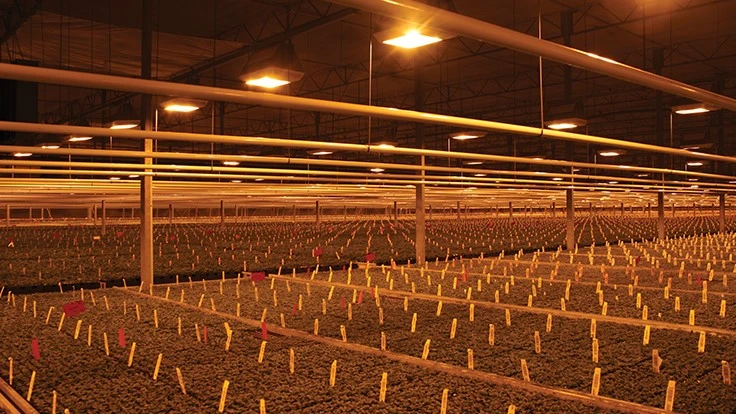

Every grower wants to reduce the costs associated with producing greenhouse crops without sacrificing quality but, rather, increasing it. One strategy to simplify finishing container-grown crops is to treat them prior to transplanting, “priming” them for easier production. This article will highlight some simple tactics you can use.
Light management can affect crop production in several ways. However, when supplemental photosynthetic light is provided to seedling plugs or rooted cuttings, the additional light during propagation can reduce the time to produced finished young plants that are toned and pullable. Plants provided with additional light during the young plant phase can also have payoffs during finishing. For example, plants grown from rooted cuttings provided with additional light during propagation can flower a week or more earlier than plants that did not receive supplemental light during propagation.
Another great example is seed geraniums (Pelargonium × hortorum). Additional light during the seedling stage also reduces the time to flower after transplanting seedlings. But it is not just supplemental light. You can also manipulate the photoperiod during propagation to induce flowering in your crops. For example, by growing petunia (Petunia × hybrida) seedlings under long days during propagation, plants can be induced to flower more quickly after transplanting. Inducing plants to flower in propagation is especially useful if you do not have the infrastructure in your finishing space, and for small containers like flats that need to flower quickly to avoid unwanted and excessive vegetative growth.
Promoting branching is another goal for most container-grown ornamental crops. It improves crop appearances and can help fill in containers. Certain crops cannot be pinched during propagation, such as poinsettia (Euphorbia pulcherrima) and kalanchoe (Kalanchoe blossfeldiana). Rather, these crops are usually pinched after cuttings are planted and rooted in their containers and a sufficient number of leaves have unfolded that will yield the branches we want following pinching (i.e. leaving five or six leaves on a poinsettia cutting to get five flowering stems on the finished plant). However, there are other crops such as some annual and perennial bedding plants, as well as some containerized herbs, which may be pinched or sheared to not only control growth, but enhance branching. For these crops, running flats through a trimming machine prior to planting is a very effective method of promoting branching. Plus, you can reduce or eliminate the need to shear or pinch the plants after they are transplanted and spaced out in the greenhouse.
In addition to physical growth regulation, chemical growth regulators can also be applied to young plants prior to transplanting to streamline finishing and improve quality. A few herbaceous annuals and perennials can be treated with ethephon and/or benzyladenine to enhance branching. Furthermore, anti-gibberellin growth regulators are widely used throughout finishing to control plant size. But for both branching and height control, there are application methods and strategies that can be used for applying PGRs that can reduce and, in some instances, eliminate treatments after plants are in their final container size and spacing.
One of the most useful techniques is a liner or plug dip. Placing a tray or rooted cuttings or seedlings into a PGR solution for 30 seconds to two minutes can be an effective application method for those compounds which can be taken up by roots in addition to shoots, such as benzyladenine and the growth-suppressing chemicals ancymidol, flurprimidol, paclobutrazol and uniconazole. Foliar sprays can also be used, and their timing can be adjusted to benefit finished plants. By making spray applications during stage four of the growing process — also known as toning — the majority of the growth-suppressing activity is going to occur during finishing. This is also an effective use of product and time.
For each of the examples in this article, and for similar practices not mentioned, the benefit in treating plants prior to transplanting comes down to efficiencies from the high planting density. Let’s look at an example, comparing foliar PGR spray applications of a vegetatively propagated annual. If you were to spray a 105-cell tray of rooted cuttings with a PGR prior to transplanting at the end of stage four, versus spraying those same cuttings a week after transplanting into 4.5-inch containers spaced in pot-tight shuttle trays, the footprint of the tray of cuttings is 1.38 ft2 versus 14.76 ft2 for the transplanted cuttings; the tray of cuttings is only 9% of the area of the finished plants. The high planting density of plugs and liners makes treating them an efficient use of any input — bench space, labor, chemical, energy, etc.
Look for opportunities to make production easier for you. You’ve seen young plants that are marketed to finish quickly and simply — already pinched, treated with PGRs and induced to flower. See what opportunities you have in-house to simplify and streamline finishing your crops by adding value to your young plants.

Explore the July 2019 Issue
Check out more from this issue and find your next story to read.
Latest from Greenhouse Management
- Anthura acquires Bromelia assets from Corn. Bak in Netherlands
- Top 10 stories for National Poinsettia Day
- Langendoen Mechanical hosts open house to showcase new greenhouse build
- Conor Foy joins EHR's national sales team
- Pantone announces its 2026 Color of the Year
- Syngenta granted federal registration for Trefinti nematicide/fungicide in ornamental market
- A legacy of influence
- HILA 2025 video highlights: John Gaydos of Proven Winners





